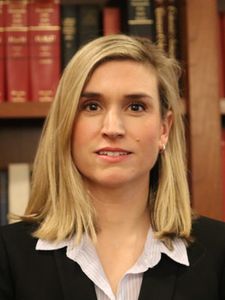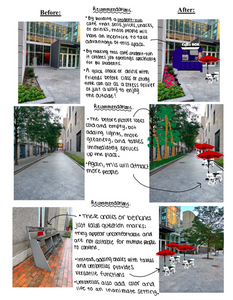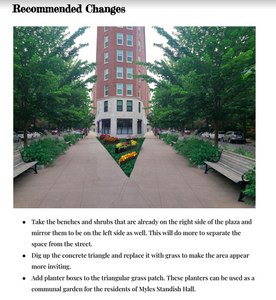CGS Syllabus: The Space and Observation Project
By Meghan Bohannon
Learning inside and outside the classroom is a hallmark of CGS’s curriculum. During the 2021 Summer Semester in New England, CGS students were given several assignments that highlighted interdisciplinary study and real-world applications for their coursework. In RH104: Rhetorical Practices from The Industrial Revolution through the Digital Revolution, taught by Senior Lecturer Stephanie Byttebier, students used the city of Boston as their inspiration to reimagine what can be done with underutilized space.
The Assignment

For the Space and Observation Project, students applied their course readings and in-class study to a thoughtful observation of the world around them as they chose spaces on BU’s campus that could be upscaled or better utilized. The RH104 curriculum progresses through various historical periods, and the Space and Observation project focused on the transition from the 19th to the 20th century, when the birth of cities led to problems associated with industrialization, such as a lack of public spaces or green spaces.
Leading up to the assignment, Byttebier’s class went on field trips throughout the Greater Boston area, including a biking tour of the Emerald Necklace, the chain of parks around Boston, and a visit to Crane Beach and the Crane Estate, a mansion built by an industrialist during the early 20th century.
Students learned in the class that urban design is intentional, and the way buildings are made directly affects human behavior. Through the Space and Observation project, students were asked to present a space, describe their observations regarding how students were or were not using the spaces, and propose recommendations for how to renovate the space.
“The way buildings are made is communicating something to us. What is it that they’re communicating and how can we intervene? How can we compose our surroundings and our spaces better so that we start behaving in different ways?” said Byttebier.
The Reading List

Byttebier had her students read several texts by authors of different disciplines to prepare for the assignment. The readings, which included Emerald Necklace designer Frederick Law Olmstead’s “Public Parks and the Enlargement of Towns,” Henry David Thoreau’s “Where I Lived and What I Lived For,” and Jane Jacob’s “The Death and Life of Great American Cities,” helped solidify students’ understanding of real-world problems such as overcrowding, which are perpetuated by increasing globalization and climate change.
“Olmsted and Thoreau knew that the Industrial Revolution brought upon a new era of bustling and urban city-spaces, and if we don’t include aesthetic and inviting common places, people will become miserable in their day-to-day lives,” said Sophia Bittner (’22, Questrom’24), who chose the walkway between the School of Theology and the School of Law to focus on for her project. “We as humans crave escapism, and being stuck in an office job does not fulfill these needs.”
Learning Goals
RH104 fulfills a unit in the BU Hub areas of critical thinking and digital/multimedia expression. Beginning with a class walk around campus, students were asked to practice critical observation as they identified spaces on campus that held room for improvement.
In relation to the multimedia and digital expression hub requirement, students were able to use their own creativity and format the assignment through their medium of choice. One popular option was Adobe InDesign, which a guest speaker visited the class to host a workshop on. The Space and Observation project, which took place around the middle of the six-week course, was a creative assignment which would prepare students for a visual opinion piece that they would use InDesign for at the end of the course.
Approaching the Assignment

Byttebier’s students had varying approaches to the assignment, but all worked toward an end goal of having the spaces be more inviting, useful, and appealing.
Kaylynn Michael (’22, CFA’24), who chose the triangular space next to Myles Standish Hall and nestled in between Bay State Road and Beacon Street, used her own experiences to imagine how the space could be reinvented.
“I thought about what would make it appealing to me personally and what would make it feel more welcoming to me,” she said.
Meanwhile, Bittner spent time sitting in her space alone, as well as consulting Pinterest to help her reimagine the space.
“I am already very passionate about architecture and design, so my whole Pinterest is filled with a mood board encompassing different styles of architecture and landscapes. I looked at these mood boards and made an assessment of what I would do to change this space,” Bittner said.
Final Grades
In the end, Byttebier’s students created thoughtful presentations for their redesigns complete with visual maps, photographs, and thorough observations. Students said the project was a fun way to express their creativity.
“I enjoyed the creative aspect of this project. I used it as an opportunity to learn how to use Photoshop and improve my photo editing skills,” said Michael. “I liked how open-ended and up to individual interpretation the project was. That was an aspect that I really liked about all of my CGS classes, the creative freedom to really do as much with each project as you wanted to.”
Bittner concurred.
“College has been a nonstop endeavor of writing papers, studying for exams, or working on problem sets,” she said. “Actually being forced to think outside the box and create something unique is what I really needed.”
CGS Syllabus is a series focused on highlighting the interdisciplinary, real-world focused projects that make the CGS curriculum unique. If you have recently participated in a CGS project you’d like to see highlighted here, please email cgscomm@bu.edu.
